Plants of Chester Creek
The Chester Creek Trail is home to hundreds of species of wildflowers, vines, shrubs, trees, and grasses with a blooming season that extends from March through October.
Learn more about the biodiversity and seasons of Chester Creek in the attachments below.
**A huge thank you to John “Mac” MacFarland for putting this together and sharing your vast ecological knowledge!!
Common Early Spring Plants

Bloodroot
(Sanguinaria canadensis)
The leaves and flowers sprout from reddish rhizome containing a bright orange/red sap, which is the reason for the genus Sanguinaria, meaning “bloody” in Latin. It was used as a red dye by tribes living in areas of its growth. It produces a single basal leaf with five to seven lobes that enclose the white flower until it blooms. Every morning it opens and at night it closes. It is insect pollinated but produces no nectar.

Common Chickweed
(Stellaria media)
This species is grown as a vegetable crop and ground cover for both human and poultry consumption, thus its name. It is edible and nutritious and often used raw in salads. Its genus name is derived from the Latin meaning “star”. Flowers are white and small with five very deeply lobed petals. Over the years, it has been used medicinally for iron-deficiency anemia as well as skin diseases and bruises.

Common Fleabane
(Erigeron philladelphicus)
This species is native to North America and is a member of the daisy family. Introduced to Europe and Asia, it is considered an invasive species there. It can be found growing along roadsides, in fields, in thickets, and in open woods. The flower heads are borne in arrays of as many as 35 heads. Each head may sometimes contain as many as 400 pink or white ray florets surrounding yellow disc florets.

Common Spicebush
(Lindera benzoine)
Common spicebush is a member of the laurel family. Its leaves, buds, and new growth twigs can be made into a tea. The fruits can be dried, ground, and used as an allspice substitute. Local tribes used it as a treatment for multiple ailments. Many animals feed on the leaves, twigs, and berries, including deer, game birds, and songbirds. When crushed, its leaves emit a spice-like aromatic odor, thus its name.

Cut Leaved Toothwort
(Caddamine concagtentata)
The roots of this plant can be washed, chopped, and ground in vinegar to be used as a horseradish substitute. Its native habitats include rich woods, wooded bottomland, limestone outcrops, and rocky banks and bluffs. The leaves are on long petioles, deeply palmately dissected into five toothed segments. Its white to pinkish flowers are held above the foliage in a spike, which ripens into an elongated pod.

Dwarf Cinquefoil
(Potentilla canadensis)
This species of cinquefoil is characterized by leaves made up of five wedge-shaped leaflets. The toothed leaflets are rounded, but lack teeth below the middle. The stems are densely silver-hairy. The flowers are five-petaled and yellow in color. Along with the leaflets on each leaf, this gives way to the name from the Latin “cinque” meaning five. They grow from an overground runner of a stem, and its presence is an indicator of impoverished soil.

Eastern Redbud
(Cercis canadensis)
The flowers of this southern shrub are light to dark magenta pink in color and appear in clusters on bare stem before the leaves. Long-tongued bees pollinate the flowers. The leaves are alternate, simple, and heart shaped, long and wide, thin and papery, and may be slightly hairy below. The flowers can be eaten fresh or fried. Tribes in the area consumed the flowers raw or boiled, and ate the roasted seeds.

Flowering Dogwood
(Cornus florida)
This flowering tree is commonly planted as an ornamental in residential and public areas. The leaves are opposite, simple, ovate, long and broad, with an apparently entire margin. They turn a rich red in autumn. The flowers are individually small and inconspicuous. Around twenty flowers are produced in a dense, rounded, umbel-shaped flower head surrounded by four conspicuous large white or pink bracts (not petals) with a distinct notch at the apex.

Garlic Mustard
(Allaria petiolata)
This member of the mustard family is a highly invasive species introduced by European settlers. In the first year of growth, plants form clumps of round wrinkled leaves that when crushed smell like garlic. The plants flower the next spring producing cross-shaped white flowers in dense clusters. The crushed seeds are used as a mustard substitute. It is one of the oldest spices used in Europe.

Gill-Over-The-Ground
(Glechoma hederacea)
This member of the mint family is also called Ground-ivy, Creeping Charlie, and Run-Away-Robin. It thrives in moist shaded areas, but also tolerates sun. It thrives in lawns and around buildings as it survives mowing. In the United States, it is considered an invasive species. But, in Europe it was cultivated and used in the brewing of ale before the current use of hops, as well as a medicinal compound.
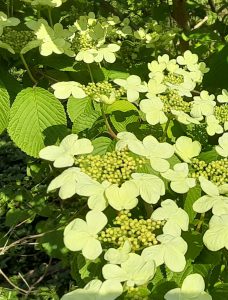
Hobblebush
(Viburnum lantanoides)
This perennial shrub has pendulous branches that take root where they touch the ground forming obstacles, which easily trip walkers-hence the common name. It grows to heights of six feet and has opposite large heart-shaped leaves. The flowers form large, flat clusters and are very white. The Algonquin reportedly rubbed its mashed leaves on the head to treat migraines. The Iroquois as a blood medicine.

Indian Strawberry
(Duchesnea indica)
This species is one that spreads along the surface of the ground by long running over-ground stems. Its leaves are compound and made up of three leaflets that are ovate and pointed with deeply cut edges. They are found on a separate stalk from the flowers. The flowers are yellow in color and spring from the leaf nodes. The five yellow petals are backed by distinct three-lobed bracts., exceeding the petals and sepals. The fruit is strawberry-like, but inedible.

Jack-In-The Pulpit
(Arisaema atrorubens)
This species is distinctive with its three-part leaves and flowers contained in a spadix that is covered by a hood. The oxalic acid found in the plant is poisonous if ingested. However, if cooked, it can be eaten as a root vegetable. If sliced and dried, it can be eaten like potato chips, or ground into flour. The oxalate crystals give it a peppery flavor. It has been used to treat sore eyes, rheumatism, and snake bites.

Jetbead
(Rhodotypos scandens)
This species is a deciduous shrub in the Rose family. It is native to Asia. It grows to a height of five feet with opposite simple ovate leaves. The flowers are white and have four petals. The fruit is a cluster of one to four shiny jet-black berries. These are highly toxic, and may be fatal if eaten. It was introduced into the ornamental nursery trade around 1866.

Lesser Celandine
(Ficaria verna)
This species is a member of the Buttercup family, and contains a compound known as protoanemonin. Contact with crushed leaves can cause itching, rashes, or blistering on the skin. Ingesting the toxin can cause nausea, vomiting, dizziness, spasms, and paralysis. Cooking of the plant eliminates its toxicity. It is also known as Pilewort because it has historically been used to treat piles (hemorrhoids).

Mayapple (Mandrake)
(Podophyllum petatum)
These woodland plants typically grow in colonies derived from a single root. The stems grow to 15 inches tall with palmately lobed umbrella-like leaves. Flowering stems produce a pair of leaves with flowers found in the axils of the leaves. The flowers are white with six to nine petals and mature into a yellow fleshy fruit. All parts of the plant are poisonous, including the fruit until it ripens and turns yellow.

Myrtle (Periwinkle)
(Vinca minor)
This species exhibits a lavender flower with five asymmetric petals that create a pinwheel effect. It has a star outline in its center. Its leaves are glossy, evergreen, lanceolate, and opposite on the stem. It exists as a creeping ground cover, spreading from gardens. It is extensively cultivated as a groundcover because the plants are low and spread quickly. When escaped, it can become a difficult invasive species to control.

Pin (Fire) Cherry
Prunus pennsylvanica
This species may grow to heights of up to fifty feet. Neither its soft wood nor fruit have any commercial value, but the wood can be used as firewood or chips, and the fruit can be used for jams, jellies, and preserves. It can regenerate by both seed and sprout. Seeds accumulate over prolonged periods in the soil and may remain viable for a hundred years. Flowers occur in small groupings of five to seven individuals.

Purple Dead-Nettle
(Lamium purpureum)
Like all mints, this species is characterized by its square stem. It is native to Europe and Asia, so, as an escape becomes invasive. Though superficially similar to species of true nettles in appearance, it does not sting, hence the name. It is extremely beneficial to pollinating bees. Young plants can be used in salads or finely chopped for sauces. Herbalists use it for many remedies including as a salve for itchy skin.

Sensitive Fern
(Onclea sensibilis)
This species derives its name from its sensitivity to frost, the fronds dying quickly when first touched by it. It has remained essentially unchanged over millions of years as exhibited by a fifty-seven million year old fossil of Paleocene epoch flora. It propagates by both spore dispersion and rhizome growth. It is cultivated as an ornamental plant in gardens, but can become aggressive if not controlled.

Slender Speedwell
(Veronica filiformis)
This species is a native of Turkey, introduced to the United Kingdom in 1808 and first reported in the United States as an escape in 1838. The corolla is four-lobed and bluish with a white tip with the top lobe being the largest. In Ireland, it was sewn into the clothing of travellers for good luck. It reproduces from separated sections of stem and rhizome, so is easily dispersed, especially by mowing.

Spring Beauty
(Claytonia virginica)
This species honors the colonial Virginian botanist John Clayton. It is a trailing perennial plant, overwintering through a tuberous root. Its individual flowers bloom for only three days. Its seeds are released from a capsule fruit and easily spread by insects. The Iroquois would eat the raw roots, believing they prevented conception. The leaves can be cooked in salted water, although not choice eating.

Tartarian Honeysuckle
(Lonicera tatarica)
This species is native to Siberia and was introduced to the United States as an ornamental plant in 1752. Of cats that do not respond to catnip, one third respond to its aromatic wood. Ingestion of the berries by humans causes diarrhea, vomiting, and abdominal pain, but not death. The berries are, however, beneficial to wildlife. Birds spread its seeds through their droppings. The flowers have a sweet smell.

Virginia Bluebells
(Mertensia virginica)
This species is a spring ephemeral plant with bell-shaped sky-blue flowers. The flowers have five petals that are fused into a tube. Bees can pollinate this flower, but because of its funnel shape they must hover, making them rare pollinators. Butterflies are the most common pollinators as they can perch on the edges. Early tribal societies used it for medicines, but there is no scientific proof that they work.

Virginia Spiderwort
(Tradescantia virginina)
This species is a perennial herbaceous plant with alternate, simple leaves, on tubular stems. The flowers can be blue, purple, magenta, or white. It prefers moist soils, but can adapt to drier garden soils. It is a southern plant that has escaped in the north, as it is commonly grown in gardens, due to its attractive flowers. As an escape, it is found growing wild along roadsides and railway lines.

Yellow (Tulip) Poplar
(Liriodendron tulipfera)
This species of tree with its characteristic tulip like flowers can grow to heights of one hundred fifty feet. The largest tree is Eastern North America is a Tulip Poplar in the Great Smoky Mountains that is one hundred ninety-two feet tall. It is valued by landscapers for its use as a shade tree, for its wood as building material due to its resistance to termites, and as a sculpting medium for wood carvers.

Yellow Trout Lily
(Erythronium americanum)
This species derives its name from its gray-green leaves mottled with brown or gray, which allegedly resemble the coloring of Brook Trout. It blooms in early spring before the trees growing above them develop leaves. This time allows them unobstructed access to sunlight for photosynthesis and time to grow when soil nutrient levels are highest. The flowers close at night and open again in the sunlight.
Common Late Spring Plants
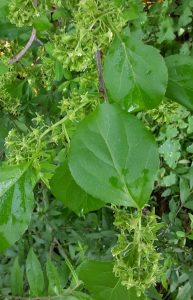
American Bittersweet
(Celastrus scandens)
This species is a sturdy perennial vine that may have twining, woody stems that are thirty feet or longer. The stems are yellowish-green to brown and wind around other vegetation, sometimes killing it. It has tiny, scentless flowers that grow at the tips of the branches. It has colorful, orange fruits that are the size of a pea, which reminded colonists of “Solanum” species, thus the common name. These fruits are poisonous to humans, but are favorites of birds.

Arrowwood
(Viburnum dentatum)
This species is a small shrub and, like most Vibrurnum species, has opposite, simple leaves. In this species they are ovate with heavily notched edges. This foliage turns yellow to red in the fall. Its white flower clusters are found in umbrels at the ends of short stems and mature into bluish berries that are held in a drupe. These are a food source for many songbirds. Indigenous people used the young straight stems to make arrow shafts, thus the common name.
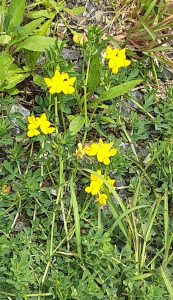
Birdsfoot Trefoil
(Lotus corniculatus)
This species is a member of the Clover family and thus a legume able to enrich soils. It is characterized by having leaves with five leaflets. There are three clover-like leaves on each stalk above two more at the base, appearing like large stipules. The flowers are yellow in color turning red later, and grown is a cluster of three to six blooms. It can be erect or prostate. Its slender seed pods suggest the foot of a bird, thus the common name.
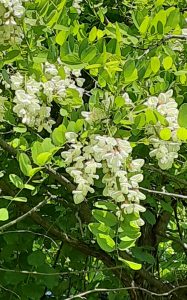
Black Locust
(Robinia pseudoacacia)
Another common name for this medium-sized hardwood deciduous tree is “False Acacia”. This is a translation of its specific name from the Greek “pseudo”, meaning fake. It is not native to our area, but has been planted for years as an ornamental tree. Its dark blue-green compound leaves have a contrasting lighter underside. It is shade-intolerant. The cream-white flowers with a yellow blotch in the center are arranged in loose drooping clumps.

Black Medick
(Medicago lupulina)
This species is a prostrate plant that suggest hop clovers, but has downy stems and produces black seedpods, thus the common name. Its clover-like three-leaflet leaves ae often minutely spine-tipped. Its yellow flowers are small and grow from individual stalks from the leaf axils. It is an annual or short-lived perennial growing each year from adventitious buds on the roots. Like other legumes, the roots contain nodules hosting nitrogen-fixing bacteria.

Broadleaf Cattail (Bulrush)
(Typha latifolia)
This species is a tall marsh plant that grows to as much as nine feet in dense stands. Its leaves are erect and bladelike. The stems are stiff and support a sausage-like brown head of minute, tightly packed pistillate flowers. Above this is a slender “tail” of paler staminate flowers. In this species the staminate “tail” touches the pistillate part. The rhizomes, young flower spikes, young shoots, and rootstocks were all used for food or medicine by indigenous peoples.

Bulbous Buttercup
(Ranunculus bulbosus)
This species, like all in the Buttercup family, is characterized by having deeply cut, palmate, three-segment leaves on distinct petioles. These are found in a basal arrangement below a tall flower stalk. It is a small, hairy plant with deep yellow, five-petaled flowers at the top, which display reflexed sepals. It gets its name from a bulb-like swollen underground stem, which is situated just below the soil surface. The Latin term, “Rana”, refers to the frog’s-foot appearance of its leaves.

Butterfly Weed (Orange Milkweed)
(Asclepias tuberosa
This perennial species is a member of the milkweed family but not milky, when the hairy stems are broken. Its leaves are long, broad, lanceolate, and spirally arranged along its stem. Its flowers resemble other milkweed species, except for their being orange. Each flower has five petals and five sepals and are arranged in wide umbels. These produce long spindle-shaped pods. Because Monarch butterflies do not favor it, it is not suitable for butterfly gardens.

Canada Thistle
(Cirsium arvense)
This perennial species with its numerous small lilac flowerheads and spiny foliage is extremely beneficial for pollinators, like bees and butterflies, that rely on its nectar. It forms extensive. colonies and tends to thrive in areas of moderate sunlight. Given this, it is one of the worst invasive species. Its wind-blown seeds are an important food for goldfinch and other finches. Its foliage is used as a food source for twenty species of butterflies and several species of aphids.

Carolina Cranesbill
(Geranium carolinianum)
The short-stalked pinkish-white flowers of this species are found crowded in compact clusters. The ethanol extracted from this plant has been effective in treating Hepatitis B infections. Its flowers are short lasting but are visited by bees and flower flies. Quail and Mourning Dove are known to eat its seeds, which develop from the flowers into clusters of bright brown seedpods looking much like the bills of cranes, thus the common name.

Chickory
(Cichorium intybus)
The flowers of this species are clear blue and stalkless. They hug its rigid, nearly naked stem. Its rays are square-tipped, and fringed. Its basal leaves are dandelionlike. Its rays begin to close at noon, and remain so until dawn. Its leaves have been cultivated for salad greens and its roots, once baked and ground, used as a coffee substitute or additive. One brand on the market with this feature is Luzianne.
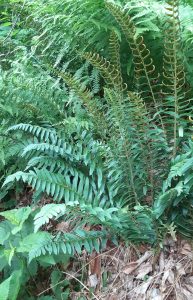
Christmas Fern
(Polystichum acrostichoides)
This is a perennial, evergreen fern native to Eastern North America. Its common name derives from the evergreen fronds, which are often still green at Christmas. Also each pinnae on a frond when held correctly looks like Santa Claus in his sled. It grows in a clump with its fronds arising from a central point. It produces fertile fronds that bear light brown spores on the edges of the upper pinnae.
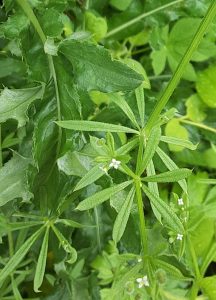
Cleavers
(Galium aparine)
This species is characterized by very scratchy, recurved prickles on its stems. Its small leaves are arranged in whorls around the stems, and are generally eight in number, distinguishing it from other species of Galium. Its star-shaped white flowers are found on small stalks growing from the leaf axils. Its creeping straggling stems branch and grow along the ground, attaching themselves to other plants by small hooked hairs, which grow out of their stems and leaves.

Common Black Berry
(Rubus allegheniensis)
This species is a member of the rose family and is commonly called “Bramble”. It is an erect plant attaining heights between five and eight feet. Usually, it forms dense thickets. Its leaves are alternate, compound, ovoid, and have toothed edges. Its stems are adorned by an armor of stiff prickles. It has five-petaled white flowers which mature into glossy, deep-violet to black edible aggregate fruit.

Common Elderberry
(Sambucus canadensis)
This species is deciduous shrub growing up to twenty feet in height. Its leaves are arranged in opposite pairs and pinnate with five to nine leaflets. Its very small, five-petaled, white flowers are held above the foliage in clusters called coymbs. The fruit is a dark purple to black berry produced in drooping clusters. Traditional methods of consuming elderberry include wine, jams, jellies, and syrups, all of which cook down the fruit and strain out the seeds.

Common Milkweed
(Asclepias syriaca)
This species is a stout downy plant. Its characteristic drooping flower clusters are found mostly in the leaf axils. Their color varies from rose to lavender to brownish purple. These mature into pointed gray-green seedpods with a warty aspect that burst open to disperse their feathery white seeds on the wind. More than 450 species of insect feed on this species, but it is most known as the most important food source of the endangered Monarch Butterfly caterpillars.

Common Mullein
(Verbascum thapsus)
This species is a hairy biennial plant that can grow up to six feet or more. During its second year of growth, small yellow flowers are found densely grouped on a tall stem, which grows from a large rosette of basal leaves. During its first year of growth, it produces only the rosette. These leaves are large and extremely soft. It has been suggested that indigenous peoples used these for innersoles in their moccasins, but they were not introduced until the arrival of Europeans.

Common Plantain
(Plantago major)
This species is characterized by broad basal leaves and a long tight flower head. The leaves are ovate or spade-shaped and strongly ribbed with troughlike stems. The young, tender leaves can be eaten raw as salad greens, but the older stringier leaves must be boiled or eaten in stews. These leaves contain calcium and other minerals, and have been commonly used in folk medicine for skin poultices on wounds, sores, or insect stings.

Cow Vetch
(Vicia cracca)
This species of vetch is finely downy and is similar to a pea in growth habit with climbing stems growing to five foot in length sending out noose-like tendrils that contact and securely fasten it to other plants. Its flowers are many, are blue-violet in color, and appear on long stalked one-sided spikes. The leaves bear eight to twelve pairs of leaflets and terminate in a that strangling tendril. Its flowers mature into tiny seeds born in a dark brown seedpod spotted with black.

Crown Vetch
(Securigera varia)
This species displays an umbel of bicolored pink and white flowers on creeping stems. Its leaves are divided into many small paired leaflets. It is native to Africa, Asia, and Europe but is commonly used throughout the United States and Canada for erosion control, roadside planting, and soil rehabilitation due to its ability, like other legumes, to fix nitrogen in the soil. Despite this benefit, it is toxic to horses and must be watched, but is not toxic to cattle, goats, and sheep.

Curled Dock
(Rumex crispus)
This species is characterized by numerous small yellow-green flowers growing along a tall infloresence or stalk with scattered wavy-edged curled leaves ascending from a large basal rosette. The largest of these flower clusters is found at the top. The flowers mature into shiny, brown seeds encased in the calyx of the flower that produced them. This casing enables the seeds to float on water and get caught on animal fur, helping disperse them.

Dame’s Rocket
(Hesperis matronalis)
This species is a garden escape that resembles Phlox. However, it has four large, showy, petals to its flowers instead of five. Upon fertilization, the flowers become the long seedpods characteristic of the Mustard family in which it belongs. Its flowers may be pink, purple, or white. The strong scent of the flowers increases toward evening. From this, it has received the genus name, “Hesperis”, which is the Greek word for evening.

Day Lily
(Hemerocallis fulva)
This species is in fact is not a member of the Lily family. It is characterized by upward-facing, tawny, unspotted, orange blossoms on a leafless stem. Its name is derived from the fact that its flowers only open for one day. Once pollinated, they form botanical capsules. Its flowers are edible, but eating in excess can cause diarrhea. In cats, however, its ingestion may be fatal. Its leaves on separate stems are long and swordlike, and are grouped into opposite arching fans.
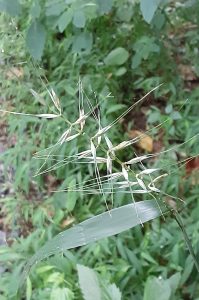
Eastern Bottle Brush Grass
(Elymus hystrix)
This species is a herbaceous perennial grass with alternate, simple leaves, on erect stems. It ranges from approximately two to five feet in height. Its flowers are white and grow in spikelets. There are usually two spikelets at each of the five to nine nodes on the stem. It has the ability to reproduce using its own pollen. It was among the first plants described by Carl Linnaeus in his survey of 1753. High in crude protein, it has a possibility as a crop for livestock.

English Plantain
(Plantago lanceolata)
This species is a familiar dooryard weed characterized by three-ribbed leaves and a long, grooved stalk topped by a short, bushy flower head. The basal leaves are lanceolate, and form a rosette. The inflorescence is ovoid and consists of many small, brown flowers with conspicuous white stamens. It is used frequently in herbal teas and other herbal remedies. Songbirds eat the seeds, and the leaves are eaten by rabbits. It can live anywhere, but does best in open areas.
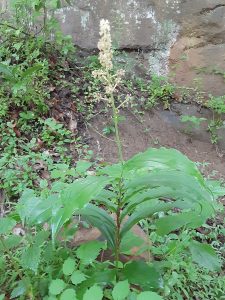
False Solomon’s Seal
(Maianthemum racemosum)
This species has oval, pointed leaves, which alternate along the stem like ladder rungs, and a gracefully reclining stem, which is tipped with a spirea-like cluster of creamy white flowers. The fruit is a berry, at first whitish speckled with brown, later ruby-red. When ripe it is edible both raw or cooked, but may be poor in taste. Consumed in large quantities, it can act as a laxative. The most robust and profuse occurrences of this plant are typically found in partial shade.

Field Garlic
(Allium vineale)
This species is a perennial, bulb-forming wild onion that exhibits either pink or white flowers or may be replaced by bulblets with tails. A single spathe is found below the bloom. Its leaves are hollow and ascend partway up the stem. As a substitute for garlic, it displays an unpleasant aftertaste. It imparts a garlic-like flavor and odor on dairy and beef products, when grazed on by livestock, and thus is considered a pestilential invasive weed throughout the United States.

Hay-Scented Fern
(Dennstaedtia punctilobula)
This species is a deciduous fern with fronds growing up to three feet in length. Its fronds are bipinnate, with each pinnae alternating closely up the stem. Its spores are located at the inner edges of each. Its common name comes from the fact that crushing it produces an aroma of fresh hay. The presence of this fern influences the dynamics of the understory of many forests. It is not browsed by deer, so is readily able to take over and restrict the growth of tree seedlings.
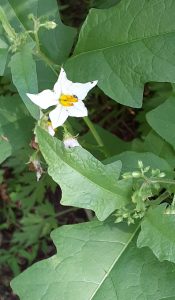
Horse Nettle
(Solanum carolinense)
This species is not a true nettle but a member of the Tomato Family. It has large alternate widely-toothed, rough leaves, attached to prickly stems. When crushed, these leaves smell like potatoes. The flowers have five petals and are usually white or purple with yellow centers. The fruits are berries that resemble small tomatoes, turning from dark green with light green stripes to yellow when mature. Unlike tomatoes, all parts of the plant, including the fruit, are toxic.

Japanese Honeysuckle
(Lonicera japonica)
This species, native to Asia, is a woody vine that is extremely difficult to eradicate. Its simple ovate leaves are found growing opposite each other along the winding stem. Its tubular flowers are white to buffy yellow in color and exhibit long, curved projecting stamens. When mature, they become black berries. Its dried leaves are employed in traditional Asian medicines, and the flowers are eaten by humans, who appreciate their sweet tasting nectar.

Lady’s Thumb (Redshank)
(Persicaria maculosa)
This annual species is a Smartweed in the Buckwheat Family. It has tight, spikelike, clusters of tiny pink or whitish flowers on knotted stems with a papery sheath at each joint. The stems are reddish, thus the common name, and the sheaths have fringes. It has narrow, alternate, linear leaves generally bearing a dark triangular blotch. Its fruit is a shiny black, three-edged achene. It does not tolerate lime, so liming is a means for controlling or eradicating it.
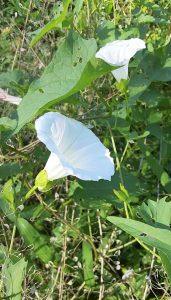
Large Bindweed
(Convolvulus silvatica)
This species is a member of the Morning Glory family. It is characterized by simple arrow-shaped leaves with blunt basal lobes that are arranged spirally around the stem. Its trumpet-shaped flowers may be white or pale pink with five darker stripes produced by the end of summer. It is a herbaceous perennial that twines around other plants, in a counter-clockwise direction. After flowering, the fruit develop as almost spherical capsules.

Maple Leaf Viburnum
(Viburnum acerifolia)
This species is a shrub about seven feet in height. Its leaves are opposite pairs, long and broad, with three to five lobes that have a serrated margin, resembling a Maple leaf, thus the species name, “acerfolia”, meaning “maple leaf”. The leaf margin has a fuzzy texture. These change to a variety of colors come autumn. Its flowers are white with five small petals, produced in terminal cymes, which mature into a small red to purple-black drupe. These berries can be made into jam.

Moth Mullein
(Verbascum blattaria)
This species is a flowering biennial plant, only producing flowers every other year. Its white or yellow flowers, with their purple centers, consist of five petals and five anther-bearing orange stamens covered in purple hairs, resembling a moth’s antennae, that are borne in a loose raceme on a tall stem, hence its common name. It has long been known to be an effective cockroach repellent, thus the species name “blattaria” derived from the Latin word for cockroach, “blatta”.

Nightshade (Bittersweet)
(Solanum dulcamara)
This species is vine-like bearing ovate leaves with two distinct lobes at the base. It flowers are five petaled, swept back, and deep violet to black in color with protruding yellow beaks formed by the anthers. The fruit appear as drooping clusters of egg-shaped berries turning from green to ruby red with maturity. Less toxic than other species of “Solanum”, the fruit have a sweet after taste, hence the common name. It was once thought to be effective against witchcraft.

Pale Touch-Me-Not (Yellow Jewelweed)
(Impatiens capensis)
This species has pendent blossoms of pale yellow with distinct spurs. The stems are watery when broken, and the sap appears to give some relief from rashes and insect bites. The flowers mature into ripe pods, which pop when touched, thus the common name. When held under water, the underside of the leaves exhibit a shiny metallic jewelry-like silvery look, thus its alternate name. Except for color, it resembles all the characteristics of Spotted-Touch-Me-Not.

Paulownia (Princess Tree)
(Paulownia tomentosa)
This species is a deciduous hardwood tree native to central and western China, and is a persistent exotic invasive species in North America. It is characterized by large elephant-ear size leaves and clusters of purple tubular flowers which mature into ovate seedpods. These lightweight seeds were commonly used as packing material by Chinese porcelain exporters in the 19th century. Packing cases would often break scattering the seeds along railroad tracks.

Persian Silk Tree
(Albizia julibrissin)
This species is named after an Italian nobleman, Filippo degli Albizzi, who introduced it to Europe in the mid-18th Century. The species name,”julibrissin”, is derived from a corruption of the Persian word for silk flower. It is a small deciduous tree with a broad crown of level or arching branches of large, frond-like, bipinnate leaves. The pink and white silky-thread-like flowers mature into large flat brown pods containing several seeds.

Plume Poppy
(Macleaya cordata)
This species is native to China and Japan, but has been introduced to the United States by gardeners. Escaping into the wild, it has become a noxious, invasive species, due to its ability to be self-seeding. It can grow up to eight feet in height, and be as much as three feet broad. It exhibits airy panicles of buff-white flowers which mature into five seeded grayish-brown seedpods. Its leaves are large and heart-shaped, thus its specific name, “cordata”.

Poison Hemlock
(Conium maculatum)
This biennial species is a large, much branched plant with finely divided, fernlike, dark green foliage. Its grooved stems are hollow and spotted with purple. It has an unpleasant smell when bruised. All parts of the plant are poisonous. Its juices are very poisonous. Its white flowers are carried at the end of a long stalk in a loose umbrel. In ancient Greece, it was used to poison prisoners, such as Socrates, condemned for having poisoned the minds of young men.

Poison Ivy
(Toxicodendron radicans)
This species can be found as a climbing vine or small shrub. It is characterized by having very small white flowers with green centers that are scattered along a stalk arising from the leaf axils. These mature into grayish or whitish berries. It has compound leaves consisting of three leaflets. It attaches itself to other vegetation by means of a hairy vine. All parts of the plant are poisonous, and contact with it can bring about a quick spreading rash. So, “Leaves of Three, Let it Be”.

Pokeweed (Poke)
(Phytolacca americana)
This species is a poisonous herbaceous perennial. It displays its simple, slightly-ovate, leaves and flowers upon a reddish stem. The greenish-white sepals of the flowers resemble petals, and are borne on a raceme. These mature into purple-black berries in drooping clusters on reddish stalks, which are a favorite food source for songbirds. During spring, shoots and leaves are edible with proper cooking. The berries were once used to make ink, thus a common name of “Inkberry”.

Porcelain Berry (Amur Peppervine)
(Ampelopsis glandulosa)
This species is an ornamental plant native to Asia that can be confused with grapes. It is a deciduous, woody, perennial climbing vine with flowers opposite its palmately lobed leaves. It climbs by tendrils to a height of twenty feet. The inflorescence is made up of small, green-white flowers born in umbels. These give way to many different colored berries, that can all be present on the same plant. It has become noxious and invasive, strangling other species.

Purple Loosestrife
(Lythrum salicoria)
This species is characterized by tapering spikes of slender, six-petaled magenta flowers often seen tinging swampy meadows. Its stems are reddish-purple and square in cross-section. Its leaves are sessile, lanceolate, wide at the based, downy, and opposite or in whorls of three. The fruit is a small capsule containing numerous minute seeds. It has been used as an astringent medicinal herb to treat diarrhea and dysentery. It is cultivated as an ornamental plant in gardens.

Red Clover
(Trifolium pratense)
This species of clover is distinguished by its round-headed, purple-red, flower heads. It is the familiar clover of fields and waysides. Its deep green, three-part leaves grow alternately from long petioles on the same stem as its flowers. They are generally marked by whitish chevrons. It has a deep taproot, which makes it tolerant to drought, and this, along with its ability to fix nitrogen in the soil, gives it a good soil structuring effect. It is widely grown as fodder.

Sallow Sedge
(Carex lurida)
This is a species of sedge and thus belongs to the Cyperaceae family. Like all sedges, it is characterized by having a triangular stem. Its flower sacs are small, slightly inflated, and with a straight beak. The female flower spikes, which are cylindrically shaped with many flower sacs, are found growing below the longer thinner male spike. It is found growing in clumps in swamps, marshes, and along pond and stream edges.

Smooth Solomon’s Seal
(Polygonaum biflorum)
This species exhibits paired yellow-green flowers that dangle from axils of alternate sessile leaves. When mature the seeds ripen into blue-back berries. It is said to possess scars on the rhizome that resemble the ancient Hebrew seal of King Solomon. Indigenous people consumed the starch-rich rhizomes, as a “potato-like” food, used it to treat gout and rheumatism, and used it to make breads and soups. The young shoots are edible both raw and boiled.

Smooth Sumac
(Rhus glabra)
This species is a spreading, open-growing shrub attaining heights up to ten feet. Its leaves are alternate, long, and compound with up to thirty oppositely paired leaflets, with each leaflet long with a serrated margin. The flowers are tiny, greenish-yellow, and produced in dense erect panicles. These later mature into edible crimson berries, which remain throughout the winter. This fruit is sour and contains a large seed, but can be made into a lemonade-like drink.

Spiny-Leaved Sow Thistle
(Sonchus asper)
This species is characterized by very spiny, curled leaves, whose eared bases enfold the smooth, angled stem. It has dandelion-like yellow flowers growing in small clusters at the top of each stem. The stems and leaves emit a milky sap when cut. The flower heads are devoid of disk flowers, containing only ray flowers in its composite head. Its edible leaves make a palatable and nutritious leaf vegetable. In many places, it is considered a noxious, invasive weed.

Spotted Touch-Me-Not (Orange Jewelweed)
(Impatiens capensis)
This orange flower is covered with red spots. It may be found growing alongside its common relative, Yellow Jewelweed. They both take their name from the characteristic that, when held under water, the leaves look like silver. Its other name comes from its seeds exploding from their capsules when touched. Juice from its stem can be an antidote for bee stings and poison ivy.

Sweet Vernal Grass
(Anthoxanthum odoratum)
This species is a short-lived perennial grass that grows in tufts with stems up to two feet tall. The leaves are short, broad, and loosely hairy. Its flower spikes are up to three inches in length with oblong shaped, crowded spikelets, which can be quite dark when young. As an agricultural grass it has a low yield, but can grow on land too acidic for other grasses. Its scent is particularly strong when dried.

Tall Nettle
(Urtica procera)
This species is characterized by its stem, which bears many bristly, stinging hairs, that cause discomfort once touched. This is of short duration, and is sometimes called the “seven-minute itch”. Its flowers are greenish-white, slender, and found spreading or drooping as clusters from the rigid stem. Its leaves are lance-shaped or narrowly egg-shaped, rounded or slightly heart-shaped at the base. It can grow up to nine feet in height.

Venus Looking Glass
(Triodanis perfoliata)
This species is wand-like in growth. Its flowers are violet in color, with five spreading lobes, not bell-like, that are tucked singly in axils of roundish clasping leaves, that are scallop-edged and shell-shaped. It produces a small, many seeded capsule as its fruit. The Cherokee make a liquid compound of its roots infused into a bath for indigestion. It is native to North and South America, but has become naturalized in China, Korea, and Australia.

Virginia Creeper
(Parthenocissus quinquefolia)
This species is a vine in the Grape family, with leaves divided into five coarsely toothed leaflets that turn brilliant red in autumn. This accounts for the specific name, “quinquefolia”, meaning “five-leaved”. It is often confused with poison ivy, which has three leaflets. Its flowers are small whitish-green blossoms borne in branching clusters, that mature into bluish-black berries. Its tendrils end in disks, rather than penetrating roots, which make it ideal for climbing masonry.

Weeping Willow
(Salix babylonica)
This species is a medium-sized deciduous tree growing up to one hundred feet in height. Its leaves are long, and thin, and alternate along the stem. Its small, greenish yellow flowers are borne on catkins. The fruit is a small capsule, which splits open when mature to release the numerous, minute, down-covered seeds. Its roots are very bitter, and have been used as a substitute for quinine to treat fever, headache, and coughs.
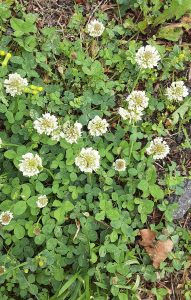
White Clover
(Trifolium repens)
Like all clovers, this species is a member of the Pea family, and is the one most associated with lawns. Its tri-pinnate leaves are born on long petioles that grow from creeping runners. Each green leaf is marked by a triangular white chevron. The flowers are typical pea-like flower heads, which are generally white tinged with pink. It derives its scientific names from the Latin, “Trifolium”, meaning three leaves, and “repens” meaning creeping.
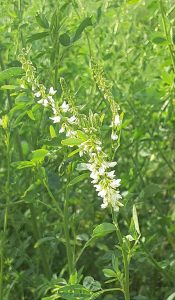
White Sweet Clover
(Melilotus alba)
This species belongs as named in the Clover family, and is, therefore a legume that can enrich soils by capturing elemental nitrogen from the air and converting it into nitrate in the soil. Its three-part leaves are cloverlike, but its flowers are not. Whether white, or yellow in a companion species, they are found in slender, tapering clusters. Its leaves are fragrant and often enhance the air, where it is growing. Its flowers are considered valuable honey plants, and are cultivated.

Wineberry
(Rubus phoenicolasius)
This species is a raspberry that was introduced from Asia. This plant is a perennial but exhibits biennial characteristics only producing flowers and fruit every other year. It has a compound leaf with three leaflets that are white underneath. The flowers have five red to pink petals on a bristly calyx growing from a short, very bristly raceme. The fruit is orange or red. The stems have red glandular hairs, giving it its scientific name from the Latin “phoenicus”, meaning red.

Wool Grass
(Scirpus cyperinus)
This species is a sedge of variable appearance that grows in dense clumps in many types of wet habitats. The fertile stems grow upright. There are five to ten extremely long leaves per stem. The inflorescence has upright or spreading branches bearing cymes of up to fifteen cylindrical or oval spikelets each. The flowers have six long bristles each, making the inflorescence look wooly. Indigenous people used it to make bags and mats or stuff pillows.

Yellow Wood-Sorrel
(Oxalis stricta)
This species is characterized by its leaves, which are comprised of three petals and look much like a shamrock rather than a clover. The flower is a five-petaled yellow blossom carried at the end of a long stalk. It matures into a seedpod which is held at a sharp angle to its bent stem. Flowers sometimes reddish at base. All parts of the plant are edible, and It is commonly called “Sourgrass” due to its distinct tangy flavor from the oxalic acid stored in its cells.
Common Summer Plants

Asiatic Dayflower
(Commelina communis)
This species gets its name because the blooms last only for a day. Its leaves are sessile and acute and lance-shaped to egg-shaped. The flowers are arranged on an inflorescence where the lateral branches arise alternately. They consist of three petals, two upper blue and one lower white, with bright yellow stamens and pistils. These develop into an ellipsoid seed capsule. In Asia, it has been used as a vegetable, a medicine, a fodder crop, and a dye pigment.

Black Cohosh (Bugbane)
(Cimicifuga racemose)
This species is a member of the Buttercup family. Its stalked compound leaves are usually divided into threes, and then further divided into threes. The flowers are found on tall racemes, have no petals or sepals, and consist of tight clusters of long white stamens, surrounding a white stigma. They have a distinct fetid smell that attracts flies, gnats, and beetles, thus its alternate name. Its roots and rhizomes were used in traditional medicine by indigenous people.
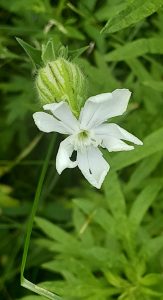
Bladder Campion
(Silene vulgaris)
This plant is easily distinguished by its heavily inflated and veined calyx sac, suggesting a tiny melon. Its white flowers are five-petaled, each deeply notched. It is native to Europe, but is a common wildflower in meadows, open woods, and fields of North America. In some countries the tender leaves are eaten raw in salads, and the older leaves are boiled or fried, sauteed with garlic, or put in omelettes.

Blue Vervain
(Verbena hastata)
This species exhibits pencil-like spikes that carry many small, five-petaled flowers, that bloom a few at a time slowly advancing to the pointed tip. Its stem is grooved and four-sided. Its lower leaves may be three-lobed, but its upper leaves are simple, opposite, lanceolate, and have double-serrated margins. The Latin, “hastata”, means “spear-shaped”. It is the host to the larvae of the Common Buckeye butterfly. It is hardy and drought resistant.

Bracken Fern
(Pteridium aquilinum)
This species is a large coarse fern. These ferns are noted for their large, highly divided fronds. The word “bracken” is of Old Norse origin, meaning fern. Its immature fronds are known as “fiddleheads” and are eaten either fresh, cooked, or pickled. Its rootstock may travel three feet or more between fronds. In cold environments, it is deciduous. Its spores, are contained in structures called sori, that rather than circular, follow the linear edges of each pinnae.

Bull Thistle
(Cirsium vulgare)
This species is the national flower of Scotland and provides a great deal of nectar for pollinators. It is a tall biennial species forming a rosette of leaves, and a flowering stem in the second. The stem has numerus longitudinal spine-tipped wings along its length. Its leaves have spines, are grey-green, and deeply lobed. The inflorescence is magenta with all the florets of similar form, with yellow tips on their bracts. The seeds have a downy pappus, assisting them in wind dispersal.

Butter-and-Eggs (Yellow Toadflax)
(Linaria vulgaris)
This species bears its snapdragon-like flowers on club-like spikes. The blooms are yellow with orange palates and thin drooping spurs. Its leaves are simple, lanceolate, extremely narrow, and numerous, and are arranged alternately on the stem. Its fruit is a globose broad capsule containing numerous small seeds. This is often grown in children’s gardens for the “snapping” flowers, which can be made to “talk” by squeezing them at the base of the corolla.

Clotbur (Cocklebur)
(Xanthium chinense)
This plant has staminate flowers in short racemes above the pistillate flowers that are enclosed in an ovoid greenish, yellowish, or brownish bur, covered with hooked spines. It has rough stems and leaves, which are long stalked, broadly egg-shaped, and coarsely toothed or lobed. It grows up to three feet in height. The bur, being buoyant, easily disperses it in the water. However, the bur, with its hooked projections, is obviously adapted to dispersal via a mammal’s fur.

Common Evening Primrose
(Oenothera biennis)
This species is characterized by its cross-shaped stigma at the heart of its four-broad yellow petals and reflexed sepals. The flowers are hermaphroditic and only last until the following noon after blooming. They open visibly fast each evening, thus the common name. Its leaves are lanceolate, long, and wide. It is a biennial with its leaves in a tight rosette the first year, and then spiraling up the stem during the second year. The fruit is a long capsule resembling an ear of corn.
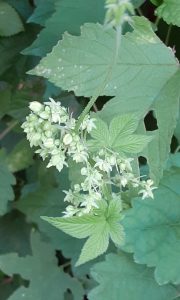
Common Hop
(Humulus lupulus)
This creeping vine is a perennial, herbaceous climbing plant that bears small greenish-white flowers in loose, axillary clusters. It leaves have three to five deep lobes. The fruit is a drooping cluster of overlapping bracts. The stem is rough and twining. It is first mentioned in the year 768, when King Pepin donated hops to a monastery in Paris. Cultivation was first recorded in 859 in Germany. It took off as a flavoring and bittering agent for beer, and remains so today.

Common Ragweed
(Ambrosia aertemisiifolia)
This common species has heavily dissected leaves and interrupted racemes of tiny nodding flower heads carrying the yellow pollen that causes hay fever. Because its leaves bear a resemblance to the leaves of Artemisia, or Wormwood, it was given its specific name. It produces tiny green to brown fruit, which persist into winter, and are rich in oil, so highly relished by songbirds and game birds.

Common Reed
(Phragmites australis)
This species of grass is characterized by having stiff, wide leaves on a coarse thick, ridged stem. Its big plumy inflorescence is comprised of many individual purple flower clusters. It is usually found growing in large colonies up to fifteen feet in height in fresh and brackish marshes and ditches. It has been used in phytoremediation water treatment rendering clean water from once polluted sources. Spreading by underground rhizomes, quickly can become invasive.
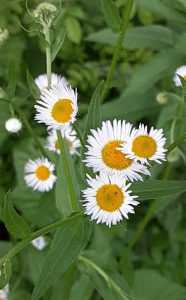
Daisy Fleabane
(Erigeron annus)
This aster-like flower, unlike asters, starts blooming in late spring. Its white rays are numerous, forty to seventy, and surround a composite center of tiny yellow disc flowers. It is hairy and leafy. Its leaves are strongly toothed, and alternate up the close-lying, hairy stems. It is cultivated as an ornamental garden plant. It is used as a food source by the larvae of several species of butterflies. It resembles the Ox-eyed daisy, thus its name, but has many, many, more rays.
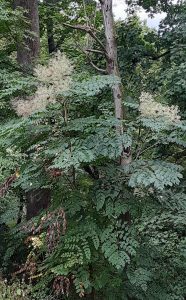
Devil’s Walking Stick (Hercules’ Club)
(Aralia spinosa)
The common names for this species of aromatic deciduous shrub are derived from the viciously sharp, spiny stems, petioles, and even leaf midribs. The leaves are clustered at the end of its branches and are bi- and tri-pinnate, three to four feet long, and two to three feet broad, and made up of numerous leaflets. Its flowers are cream white and displayed in many-flowered umbrels forming a terminal cluster. It is cultivated for its exotic, tropical appearance.

False Nettle
(Boehmeria cylindrica)
This species is nettle-like but devoid of stinging hairs. Its leaves are usually more ovate than other nettles and have three main nerves from the base. The flower clusters are compact and grow upward as two opposite racemes from the leaf axils. It is named in honor of the German botanist, Georg Rudolf Boehmer. It is sometimes called bog hemp, as it can be used as a fiber crop. It is also used as a food source for larvae of some species of butterflies and moths.

Fringed Loosestrife
(Lysimachia ciliata)
This species displays nodding, five petaled, star-like, yellow flowers that face downward with fringed or slightly toothed petals. They have broad, oppositely paired leaves with fringed, smooth, green leafstalks. The species name comes from the Latin “cilata” meaning hair. It is cultivated as an ornamental plant, but can become aggressive. Instead of nectar it offers oil, and is pollinated by the oil bee, Macropis nuda, whose survival depends upon this host plant.

Goosegrass
(Eleusine indica)
This grass is more likely native to Africa than India, as its specific name would lead one to believe. It displays toothed, jagged flower clusters. These branch and look like a closed zipper. It can grow to two feet in height, but appears smaller, as it spreads out in low tufts. Its seeds are edible, but yields are low. It is an important weed of cultivated crops, lawns, and golf courses. Both tillage and herbicides are used in its control.

Great Burdock
(Articum lappa)
This species is a biennial plant, rather tall, reaching as much as ten feet in height. It has large, alternating, wavy-edged cordate shaped leaves with long petioles and pubescence (hairs) on the underside. The flowers are purple, grouped in a globular capitula and united in clusters. The capitula are surrounded by many bracts, each curving to form a hook, allowing the mature fruits to be caried long distances on the fur of animals.

Indian Tobacco
(Lobelia inflata)
This species is the commonest lobelia. It lilac flowers are small, tucked singly into the leaf axils. The base of each flower is inflated, becoming a swollen seedpod. The sepals are long and reflexed. Its leaves are ovate and toothed and arranged alternately along the hairy stems. Chewed or smoked it has long been used as a medicinal plant but can cause sweating, nausea, vomiting, diarrhea, tremors, rapid heartbeat, mental. Confusion, convulsions, coma, or death.

Japanese Knotweed
(Fallopia japonica)
This species is an Asian plant in the Buckwheat family, and is considered an invasive in North America. It has hollow stems with distinct raised nodes that give it the appearance of bamboo. It may reach heights of thirteen feet. The leaves are broad, oval with a truncated base, and with entire margins. The flowers are small, cream or white, produced in erect racemes, and valued as an important source of nectar for honeybees, when little else is flowering.

Lamb’s Quarters (Pigweed)
(Chenopodium hybridum)
This plant is a member of the Goosefoot Family, thus the genus name, derived from the Latin “podium” meaning foot. This is a branching weed with often mealy, red-streaked stems. Its leaves are diamond-shaped, broadly Irregularly toothed, and often mealy white beneath. The flowers are small, and greenish with yellow centers. They may turn red with time. It grows on an erect stem. Its common names may be derived from its having used to feed livestock.

Lowrie’s Aster
(Aster lowrieanus)
This species of whiteish aster is distinguished by a wing or flange on the petiole where it joins the stem. This is distinctive. The lower leaves are heart-shaped, while leaves higher on the stem tend to be sessile with more rounded bases. The composite flowers, which have pale blue to white ray florets surrounding light yellow disc florets. These eventually turn purple with time. It is cultivated as a garden plant and the Ojibwa used it to make an incense to attract deer.

Pilewort
(Erechtites hieracifolia)
This native species bears a homely cluster of brush-shaped flowers with no rays. The white disk flowers barely peep from the swollen based envelope of green bracts, and leave many folks waiting for it to “bloom”, when it already has. Its stem is grooved and very strong smelling. Its leaves are toothed, alternate, and very variable. It flowers are pollinated primarily by wasps and honey bees. Its seeds are wind-dispersed, and used as a minor food source by birds.

Prickly Lettuce
(Lactuca serriola)
This species is a very tall, branched plant with many small yellow dandelion-like flowers in long narrow clusters. Each flower head has twelve to twenty ray flowers but no disc flowers. It has prickly leaves with weakly spiny margins, prickles on the midrib, and whitish veins on the undersides. It has a spineless reddish stem, which contains a milky sap of white latex used as a medicine. It can also be eaten as a salad, but has something of a bitter taste.

Purple Coneflower
(Echinacea purpurea)
This species is a daisy-like composite flower with swept back purple rays and dark red disc florets clustered into a cone-shaped head. They take their name from the Greek word, “ekhinos”, which means “sea urchin” due to its spiny central disk. Its leaves are long stalked, tapering, with rough teeth, and arranged alternately on the stem. It has long been used as a traditional medicine by indigenous peoples.

Queen’s Anne Lace (Wild Carrot)
(Daucus carota)
This species is characterized by having extremely flat clusters of white florets that form a lace-like pattern, thus the common name. Old flower clusters curl to form a cuplike ‘bird’s nest”. It has stiff three-forked bracts below its main flower cluster. The leaves are finely divided and subdivided. Like the cultivated carrot, the root of this plant is edible. The flowers are sometime battered and fried. It strongly resembles Poison Hemlock, so care must be taken in its use.

Spotted Joe-Pye-Weed
(Eupatorium maculatum)
This perennial plant grows as high as six and one-half feet in height. Stems are sometime completely purple and sometimes green with purple spots. Each plant produces numerous rose-purple flower heads with eight to twenty-two disc flowers but no ray flowers. Maculatum means spotted. It is named after Joe Pye, who was a Native American herbalist that used local plants to cure a variety of illnesses.

Square-Stemmed Monkey Flower
(Mimulus ringens)
The lobed violet lips of this species suggest a face with the mouth partly closed by a two ridged yellow palate. The flowers are in pair and carried on long stalks from the leaf axils. It leaves are oppositely arranged, lance-shaped to oblong, long, and usually clasping the stem. and its stem square ridged. It grows in a wide variety of moist to wet habitats. It seeds are available from commercial suppliers.

Straw-Colored Flat-Sedge
(Cyperus strigosus)
This species is a perennial sedge growing up to two and one-half feet in height. It is native to North America, where it grows in wet areas in many varied habitats. Its few, long, leaf-like bracts grow at the base of an erect triangular stem. Its inflorescence is a cluster of many linear-shaped, yellow-green scales on branches that radiate from the top of the stem. They are arranged perpendicular to the branch like a bottle brush.

Tall Goldenrod
(Solidago altissima)
This perennial member of the Goldenrod family grows to a height of six feet and can be found growing in open fields, meadows, roadsides, along railroads, and the edges of woodlands. Its flowers are arranged in branching clusters of numerous small, stalked yellow flower heads. Its leaves are all alternate with a rough upper surface and a densely hairy underside. Its stems also exhibit this hairy characteristic.

Thin-Leaved Sunflower
(Helianthus decapetalus)
This species of sunflower is characterized by having large, thin, serrated edged leaves that narrow abruptly into long, winged petioles. Most leaves are opposite, but upper leaves may alternate. The stem is smooth. It has composite flower heads composed of twenty to fifty disk florets surrounded by eight to twelve ray florets. The rays are often ten in number, as the species name indicates as “deca” is Latin for ten. They attract many kinds of insects.

Trailing Wild Bean
(Strophostyles helvola)
This herbaceous, climbing vine bears a light pubescence on the stem, leaves, and pods. It has three bluntly lobed leaflets. It possesses unique pea-like, pink-purple flowers with a gradually curving keel petal They are short stalked and turn greenish with age. Its flowers mature into straight seed pods, which may be up to 5 inches long and contain shiny black seeds with hairy coats. This plant was used medicinally and as food by indigenous people.

White Snakeroot
(Argeratina altissima)
This plant contains the toxin tremetol. When consumed by cattle, the meat and milk become contaminated with the toxin. When humans consume the meat or milk, it may lead to death. This plant was responsible for the thousands of deaths of the babies of western migrating pioneers., who unwittingly grazed their cows on it. It was complicit in the death of Nancy Hanks Lincoln, mother of the future president.

Wild (Canada) Lettuce
(Lactuca canadensis)
This is a very tall branched plant with a smooth whitish bloom that can grow up to ten feet in height. It displays many, pale, small, yellow, insignificant dandelionlike flower in long narrow clusters. Each flower head has twelve to twenty ray florets. But no disc florets. Its leaves are extremely variable from deeply lobed to lance-shaped. Its lower leaves can be up to ten inches in length. It contains lactucarium, a milky sap used as a medicinal herb.

Wild Bergamot
(Monarda fistulosa)
This species is named after Spanish botanist Nicolas Monardes, who wrote a book in 1574 describing plants of the New World. This plant is erect and has slender, serrated, lanceolate leaves arrange oppositely on a square hairless or sparsely hairy stem. The flowers and tubular and bilaterally symmetric, with a narrow upper lip and a wider lower lip. They are typically crowded into clusters with leafy bracts. They have a long history of medicinal use and a tea.

Wild Sensitive Plant
(Cassia nictitans)
This legume is an annual plant capable of rapid plant movement, as its leaflets fold together when touched. Leaves with five to nine pairs of leaflets. Its yellow flowers grow singularly on short stalks and have five stamens. Like other legumes, it has the ability to fix nitrogen in the soil by converting elemental nitrogen in the air into nitrite in the soil. It is an annual plant widely distributed throughout the temperate and tropical Americas.
Common Autumn Plants

Pasture Thistle
(Cisium pumilum)
This is a biennial plant that grows up to forty inches in height on a typically hairy stem. It blooms only once before dying. Its leaf blades are slender with stout very long spines and are up to twelve inches in length. The flower heads are sweetly scented and are pink, purple, or even white in color with no ray florets. It has the largest flowers of all the local thistle species.
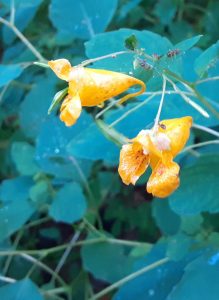
Spotted Touch-Me-Not
(Impatiens capensis)
This orange flower is covered with red spots. It is also called Orange Jewelweed. It may be found growing alongside its common relative, Yellow Jewelweed. They both take their name from the characteristic that, when held under water, the leaves look like silver. Its other name comes from its seeds exploding from their capsules when touched. Juice from its stem can be an antidote for bee stings and poison ivy.

Purple-Stemmed Aster
(Symphyotrichum puniceum)
A hairy purple stem is a characteristic of this aster. Its flowers consist of yellow to cream-colored disc florets surrounded by dark blue to purple ray florets. Its disc florets become pink or purple with maturity. It seldom forms dense colonies but is rather found as small clusters or scattered individuals. Various Native American tribes have found medicinal uses for this plant to include curing colds and fevers.

White Snakeroot
(Argeratina altissima)
This plant contains the toxin tremetol. When consumed by cattle, the meat and milk become contaminated with the toxin. When humans consume the meat or milk, it may lead to death. This plant was responsible for the thousands of deaths of the babies of western migrating pioneers., who unwittingly grazed their cows on it. It was complicit in the death of Nancy Hanks Lincoln, mother of the future president.

Tall Goldenrod
(Solidago altissima)
This perennial member of the Goldenrod family grows to a height of six feet and can be found growing in open fields, meadows, roadsides, along railroads, and the edges of woodlands. Its flowers are arranged in branching clusters of numerous small, stalked yellow flower heads. Its leaves are all alternate with a rough upper surface and a densely hairy underside. Its stems also exhibit this hairy characteristic.

Spotted Joe-Pye-Weed
(Eupatorium maculatum)
This perennial plant grows as high as six and one-half feet in height. Stems are sometime completely purple and sometimes green with purple spots. Each plant produces numerous rose-purple flower heads with eight to twenty-two disc flowers but no ray flowers. Maculatum means spotted. It is named after Joe Pye, who was a Native American herbalist that used local plants to cure a variety of illnesses.

Plume Poppy
(Macleaya cordata)
This five-seeded poppy is used ornamentally. It is native to China and Japan. It is a large perennial that grows up to eight feet in height. It has olive green heart-shaped leaves and buff white flowers on airy panicles during summer. It self-seeds readily and easily becomes invasive. It was originally bred at Kew Gardens in England. It is named for Alexander McLeay (1767 to 1848), a British entomologist.

Pokeweed
(Phytolacca americana)
This is a poisonous perennial plant that grows up to ten feet in height. It has simple leaves on green, red, or purplish stems. The flowers are green to white, followed by berries that ripen to purple or almost black and are a food source for many species of songbirds. Native Americans used its berries for a purple dye. In early Spring, shoots and leaves are edible with proper cooking, but later become poisonous.

Porcelain Berry
(Ampelopsis glandulosa)
This is an ornamental plant that is native to temperate areas of Asia. Due to its leaves, it is early confused with species of grapes. It is a deciduous, woody, perennial climbing vine with flowers and tendrils opposite the palmate three to five lobed leaves that are white beneath. It climbs by means of tendrils. Its small green-white flowers become green, blue, purple, pink, yellow, or black berries.
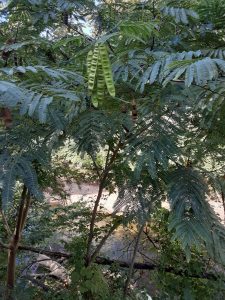
Persian Silk Tree
(Albizia julibrissin)
This tree is native to southwestern and eastern Asia. It is named after an Italian nobleman, Filippo degli Albizzi, who introduced it to Europe in the mid-18th century. It is a deciduous tree that grows up to fifty feet in height and whose canopy is shaped like a canopy. The leaves are fern-like and feathery in appearance. The dark pink flowers are showy and wispy. Its six-inch seed pods are flat and linear.
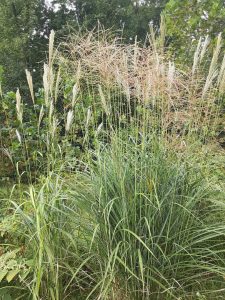
Chinese Silver Grass
(Miscanthus sinensis)
This grass is native to eastern Asia. It made an entrance into occidental gardens about a century ago due to its spectacular feathery plums that tower above their graceful arching foliage. It grows in distinctive clumps and can be up to twelve feet in height. It has been bred to produce various erect, airy, plumed seed heads from pale silver to purplish-red in color depending on the variety.

Christmas Fern
(Polystichum acrostichoides)
This is a perennial, evergreen fern native to Eastern North America. Its common name derives from the evergreen fronds, which are often still green at Christmas. Also each pinnae on a frond when held correctly looks like Santa Claus in his sled. It grows in a clump with its fronds arising from a central point. It produces fertile fronds that bear light brown spores on the edges of the upper pinnae.

Arrow-Leaved Tear Thumb
(Persicaria sagittata)
This is an annual herb with prickles along the stem. It can be up to six feet in length and often climbs over adjacent vegetation. Leaves can be heart-shaped or arrowhead-shaped. Flowers vary from white to pink and are found in clusters that are spherical or elongated in shape. They are replaced by varied colored fruit in similar clusters.

Mugwort
(Artemisia ulgaris)
This is a tall perennial plant growing up to two and one-half feet in height. It spreads through dispersal of root rhizome fragments rather than seed dispersal. The leaves are dark green, pinnate and sessile, with dense, white hairs on the underside. The erect stems are grooved and have a red-purplish tinge. It has rather small florets with yellow or dark red petals.

Bur Cucumber
(Sicyos angulatus)
This annual herb is a climbing vine that can be up to twenty-five feet in length. The alternate leaves can be up to eight inches in length with three to five palmate lobes. The stems are furrowed and quite hairy. The plant is monoecious and produces both staminate (male) and pistillate (female) five-petal flowers on the same plant. They climb from one location to another using numerous tendrils.

Late Flowering Thoroughwort
(Eupatorium serotinum)
This plant is also known as Late Boneset due to its fall blooming season. Like other members of Eupatorium it grows up to nearly seven feet in height, but its leaves are stalked on purple stems. It has dense inflorescences containing a large number of tiny white flower heads with nine to fifteen disc florets but no ray florets. It is insect pollinated unlike other species of Eupatorium that are pollinated by the wind.

Pennsylvania Smartweed
(Polygonum pennsylvanicum)
This plant is in the buckwheat family. It may grow up to six and one-half feet in height. Its lance-shaped leaves reach three-quarters of an inch in length. Its inflorescences grow at the top of the stem and from the leaf axils. The flowers are pinkish in color. This plant is an important part of the habitat for birds that feed on its seeds. Several Native American tribes have various medicinal uses for it.

Horseweed
(Erigeron canadensis)
This annual plant grows up to five feet in height on sparsely hairy stems. Its leaves are unstalked, slender, up to four inches in length, with a coarsely toothed margin. They grow in an alternate spiral up the stem. The flowers are produced in dense inflorescences with each individual flower having a ring of white or pale purple ray florets and a center of yellow disc florets. The seeds are tipped with a white down.

Small White Aster
(Aster vimineus)
This is one of the many species within the Aster family. Aster is derived from the Greek and Latin words for “star” just as in asteroid. This name comes naturally from their many ray flowers around a central cluster. Small white daisy-like flowers that are crowded closely together along purple stems characterize this species. It may grow as high as five feet in fields and meadows with partial shade.

Small White Aster
(Aster vimineus)
This is one of the many species within the Aster family. Aster is derived from the Greek and Latin words for “star” just as in asteroid. This name comes naturally from their many ray flowers around a central cluster. Small white daisy-like flowers that are crowded closely together along purple stems characterize this species. It may grow as high as five feet in fields and meadows with partial shade.